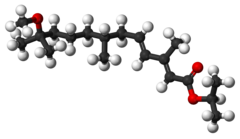Methoprene

| |
| Names | |
|---|---|
| Preferred IUPAC name
Propan-2-yl (2E,4E)-11-methoxy-3,7,11-trimethyldodeca-2,4-dienoate | |
| Other names
Methoprene, Altosid, Apex, Diacan, Dianex, Kabat, Minex, Pharorid, Precor, ZR-515
| |
| Identifiers | |
3D model (JSmol)
|
|
| ChEBI | |
| ChEMBL | |
| ChemSpider | |
| ECHA InfoCard | 100.049.977 |
| KEGG | |
| MeSH | C093000 |
PubChem CID
|
|
| UNII | |
CompTox Dashboard (EPA)
|
|
| |
| |
| Properties | |
| C19H34O3 | |
| Molar mass | 310.48 g/mol |
| Appearance | Liquid |
| Boiling point | 100 °C (212 °F; 373 K) at 0.05 mmHg |
| Pharmacology | |
ATCvet code
|
QP53AX28 (WHO) |
| Hazards | |
| Main hazards | Eye irritant |
Except where otherwise noted, data are given for materials in their standard state (at 25 °C [77 °F], 100 kPa). | |
| Infobox references | |
Methoprene is a juvenile hormone (JH) analog which acts as a growth regulator when used as an insecticide. It is an amber-colored liquid with a faint fruity odor.
Methoprene does not kill insects. Instead, it interferes with an insect’s life cycle and prevents it from reaching maturity or reproducing.[2] Juvenile growth hormones must be absent for a pupa to molt to an adult, so methoprene-treated larvae will be unable to successfully change from pupae to adults. This breaks the biological life cycle of the insect, preventing recurring infestation.
Methoprene is considered a biological pesticide because rather than controlling target pests through direct toxicity, methoprene interferes with an insect’s lifecycle and prevents it from reaching maturity or reproducing.[3]
Applications[]
Methoprene is used in the production of a number of foods, including meat, milk, mushrooms, peanuts, rice, and cereals. It also has several uses on domestic animals (pets) for controlling fleas.
It is used in drinking water cisterns to control mosquitoes which spread dengue fever and malaria.[4] Methoprene is commonly used as a mosquito larvicide used to help stop the spread of the West Nile virus.
Methoprene is also used as a food additive in cattle feed to prevent fly breeding in the manure.
Health and Safety Issues[]
According to the Safety Data Sheet (SDS), methoprene is a material that may be irritating to the mucous membranes and upper respiratory tract, may be harmful by inhalation, ingestion, or skin absorption, may cause eye, skin, or respiratory system irritation and is very toxic to aquatic life.[5] The GHS signal word is "Warning," with notes such as P273 Avoid release into the environment and P391 collect spillage.
Methoprene is suspected to be highly toxic to lobsters.[6]
References[]
- ^ Merck Index, 11th Edition, 5906.
- ^ https://www3.epa.gov/pesticides/chem_search/reg_actions/reregistration/fs_PC-105401_1-Jun-01.pdf
- ^ "Insect Growth Regulators: S-Hydroprene (128966), S-Kinoprene (107502), Methoprene (105401), S-Methoprene (105402) Fact Sheet" (PDF). U.S. Environmental Protection Agency Office of Pesticide Programs. 2015-08-20.
- ^ "Methoprene" (PDF). Water Sanitation and Health. World Health Organization. 2008.
- ^ "Methoprene Materials Safety Data Sheet" (PDF). MSDS for Methoprene. Cayman Chemical. 2019.
- ^ Walker, A. N.; Bush, P.; Puritz, J.; Wilson, T.; Chang, E. S.; Miller, T.; Holloway, K.; Horst, M. N. (2005). "Bioaccumulation and Metabolic Effects of the Endocrine Disruptor Methoprene in the Lobster, Homarus americanus" (PDF). Integrative and Comparative Biology. 45 (1): 118–26. doi:10.1093/icb/45.1.118. PMID 21676752.
External links[]
- Methoprene Pesticide Fact Sheet - Environmental Protection Agency
- Methoprene Pesticide Information Profile - Extension Toxicology Network
- Methoprene in the Pesticide Properties DataBase (PPDB)
- Insecticides
- Carboxylate esters
- Ethers
- Dienes
- Isopropyl esters